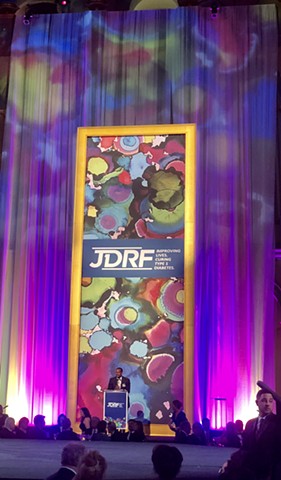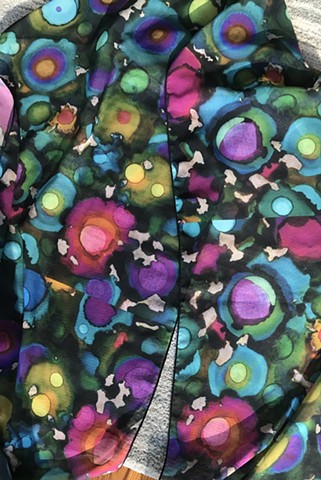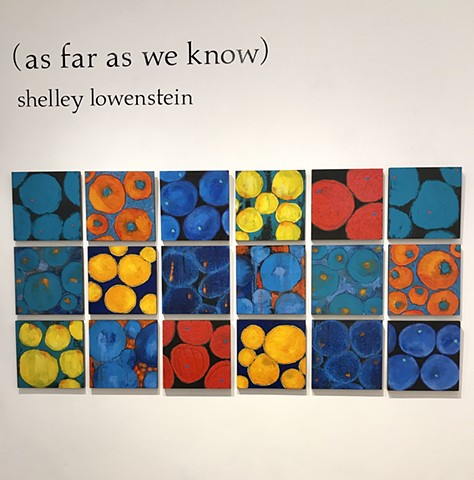Three Years in a Row
For three years in a row, the JDRF DC Chapter has used Shelley Lowenstein's beta cell paintings as their design theme for their annual gala. Each year, they select a painting that is colorful and appealing and representative of the vitally important beta cell, the hardest working cell in the body.
This image is from the record-breaking Gala from 2018 held at the National Building Museum in DC.
The 2020 anniversary gala will be held online, due to the pandemic, and also feature Lowenstein's work.
Beta Cells Scarves in Silk
NOW IN HABOTAI SILK!!!
This design was featured at the 2018 Washington DC JDRF Gala.The scarves are now available in two sizes.
10 x 45"
16 x 72"Taking orders now.
shelley@shelleylowenstein.com
Artist Finds Beauty in Beta Cells
While most people can confidently name a variety of cells including brain cells, skin cells, liver cells, white blood cells, and assert that each is critical to a person’s health, beta cells tend to remain in relative anonymity. Even among the millions of Americans living with type one diabetes (T1D), beta cells are rarely a conversation topic. Shelley Lowenstein aims to elevate awareness of beta cells through her art. A spring 2018 exhibition of this work was held at Touchstone Gallery in Washington, D.C., sparking great interest.
Shelley Lowenstein’s daughter was diagnosed with T1D at the age of 14. As do many parents whose children have T1D, Shelley wanted to help improve diabetes care, and help find a cure by raising awareness. A writer by trade, Shelley began writing about T1D for various publications. She frequently contributed to the children’s section of the American Diabetes Association magazine, and once wrote a column for Newsweek about her family living with T1D.
By coincidence, around the time of Shelley’s daughter’s diagnosis, a nationally acclaimed artist in Shelley’s neighborhood was teaching classes. Shelley took the classes and began producing art seriously. It helped her focus on her work and family. While Shelley continued to write about T1D, painting remained strictly a creative outlet. That was until a couple years ago. “For years and years I’ve been a figurative painter, painting people, and places. Eventually, I needed a break from that, and since I usually told stories about people and places, I decided to tell the story of the beta cell,” recalled Shelley.
“The beta cell is remarkable, it’s got a great story. We’re all born with a relatively small number of beta cells, probably the size of a fingertip. Yet, they are working 24/7 producing insulin that all of us need to live. I want people to see it for the rock star it is”, said Shelley. While Shelley has nothing against it, she is adamant about her work not being scientific illustrations. She continued, “Scientists will figure out how to make them [beta cells] work better for everybody. In the meantime, I wanted to raise awareness by figuring out ways to show people healthy, happy beta cells. My work is extremely optimistic. It’s a celebration of beta cells. ”
Describing her approach to the subject, Shelley said, “Working at National Geographic and Discovery had a profound impact on me. When I was given an assignment, it was usually about science and I developed a love of it [science]. I had to talk to a lot of scientists and that experience carried over into how I began learning about beta cells.” Perhaps paraphrasing Aristotle, Albert Einstein once said “The more I learn, the more I realize how much I don’t know.” Shelley would attest to the statement’s validity, as she found through her many interactions with scientists that although knowledge about beta cells has exploded in recent years, there is so much more we don’t know. Hence, her show’s title “(as far as we know)”.Touchstone Gallery Blog
https://touchstonegallery.wordpress.com/tag/shelley-lowenstein/


